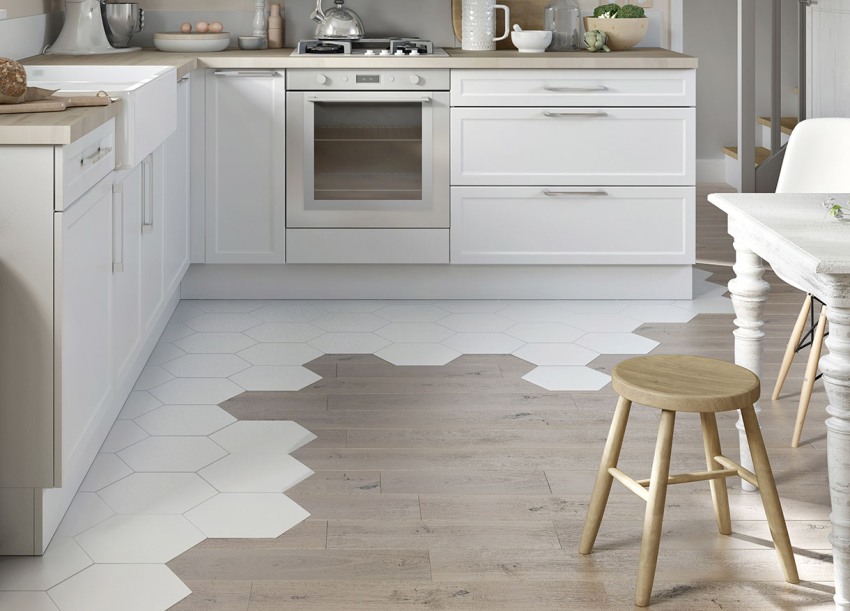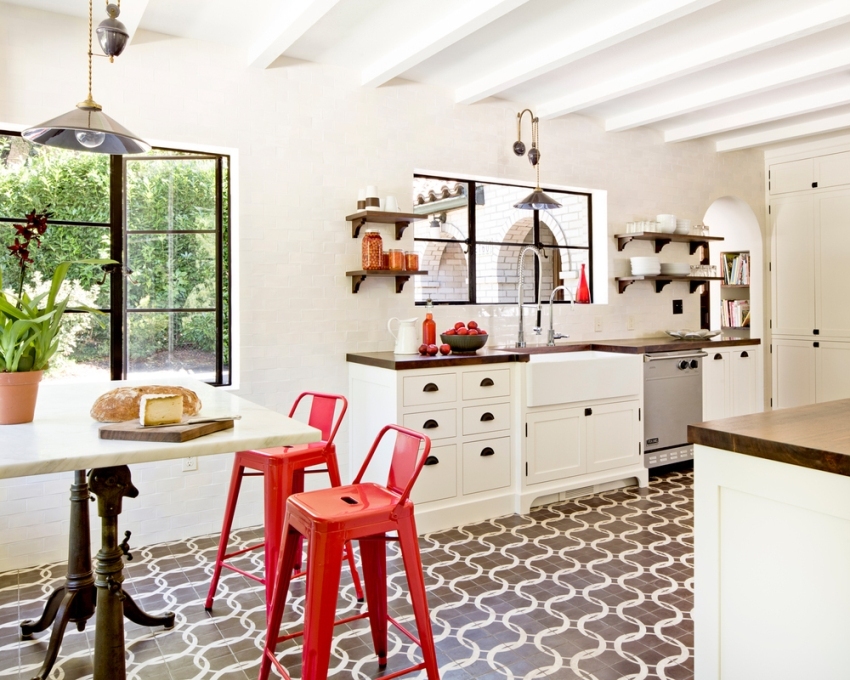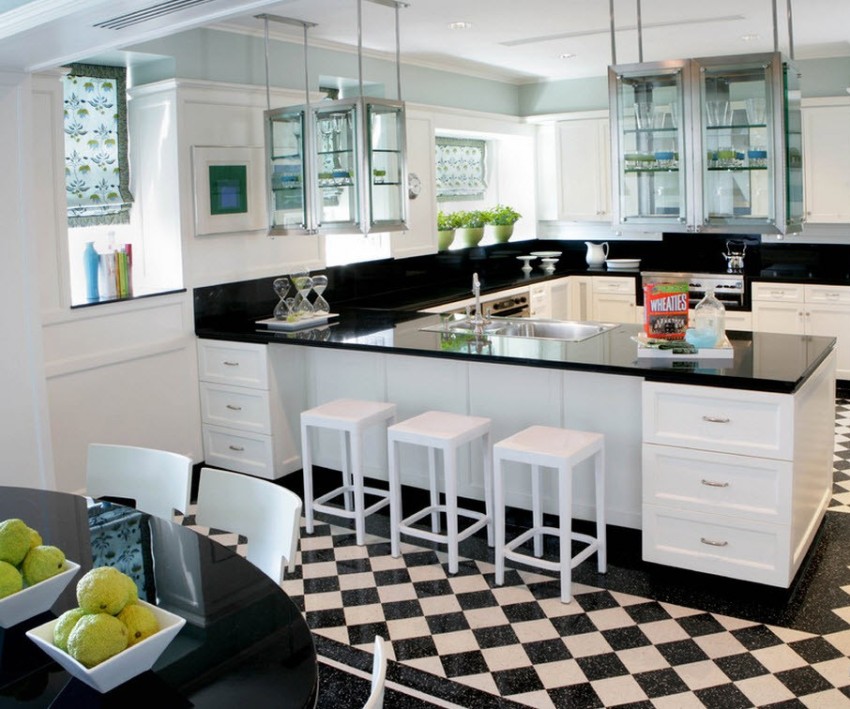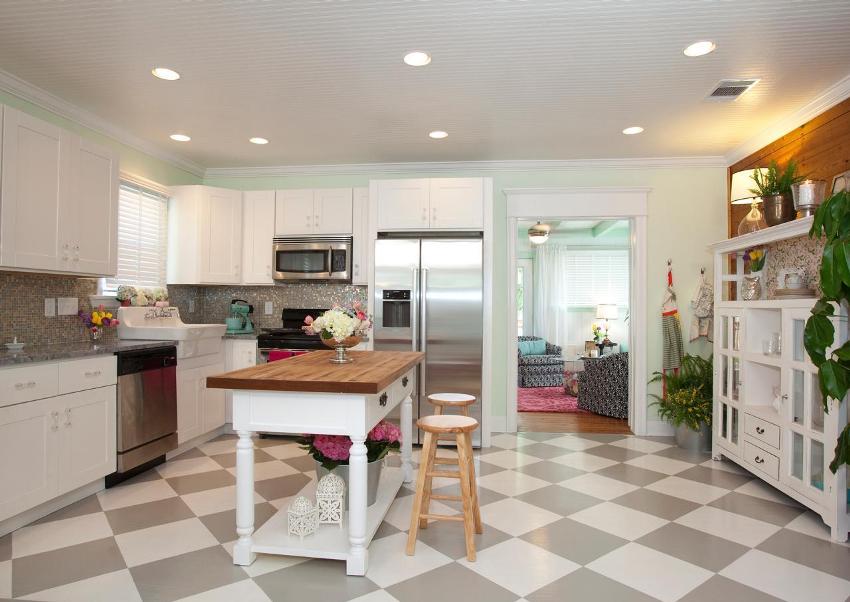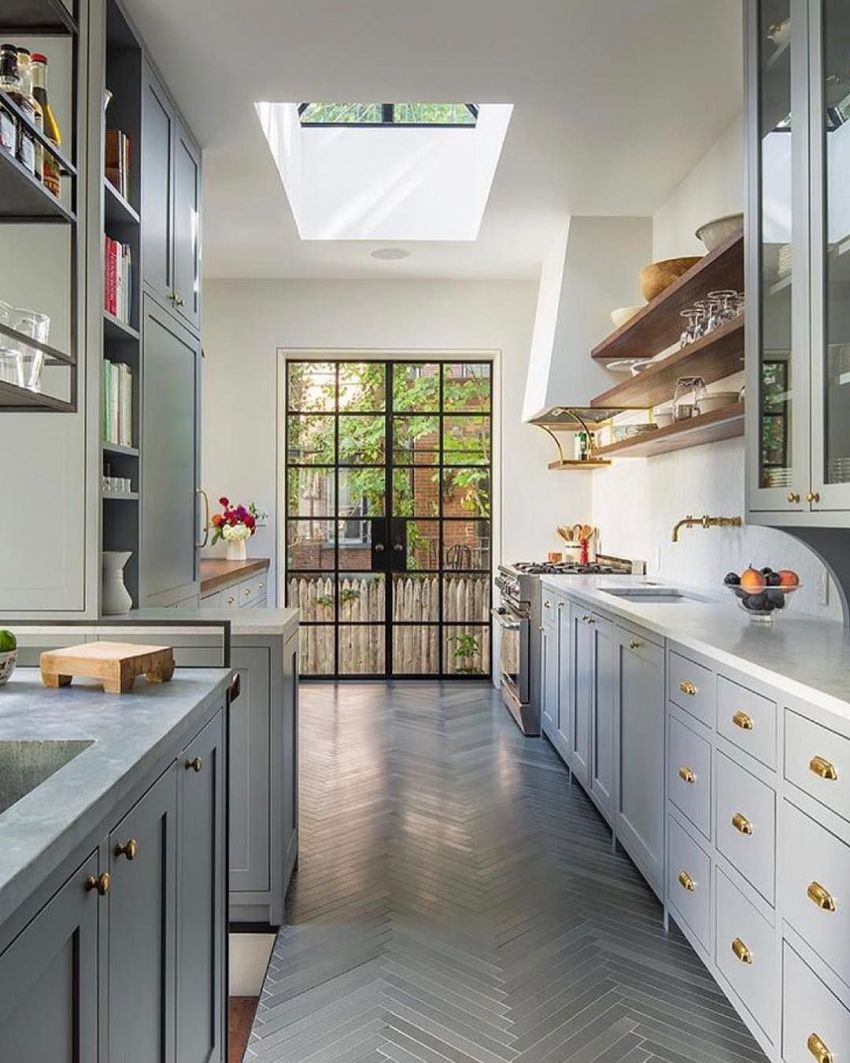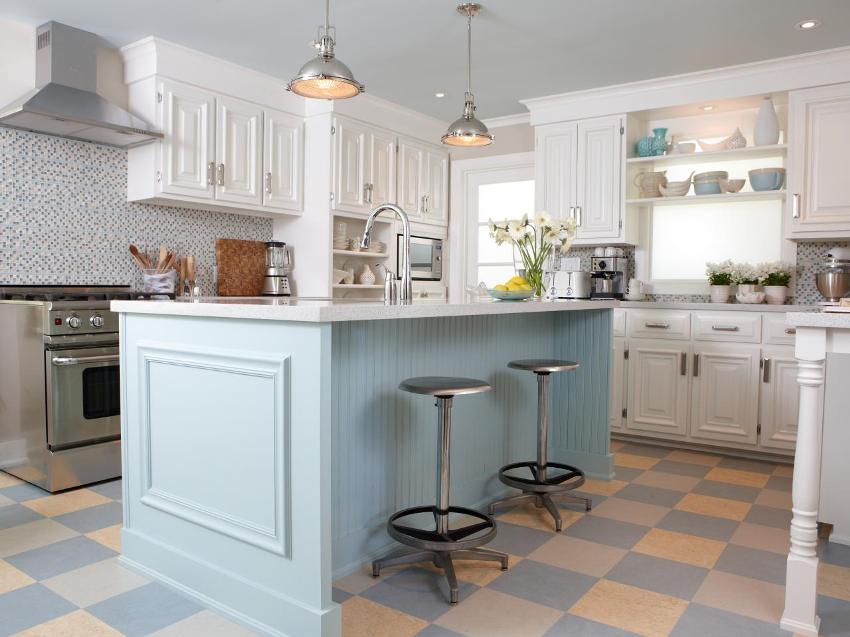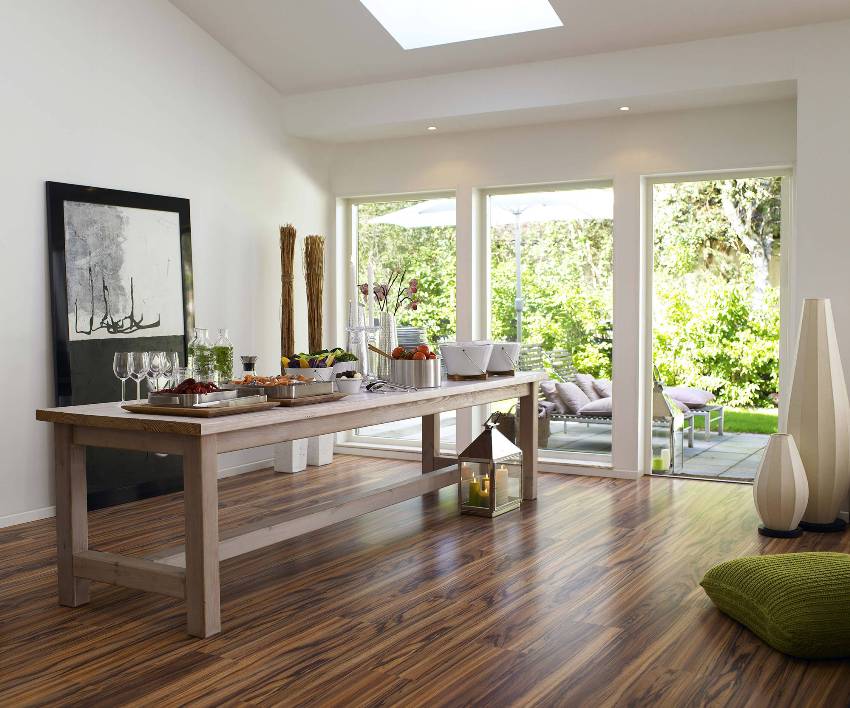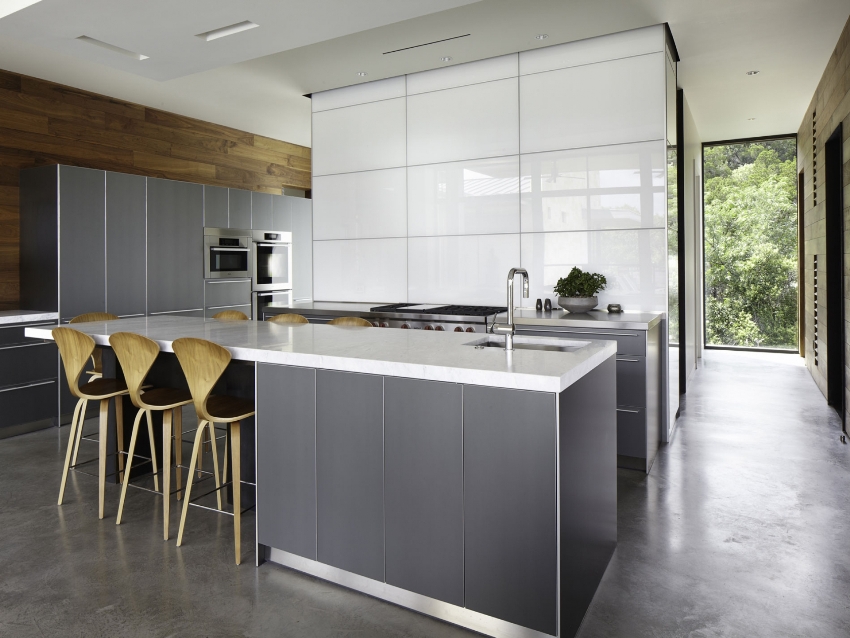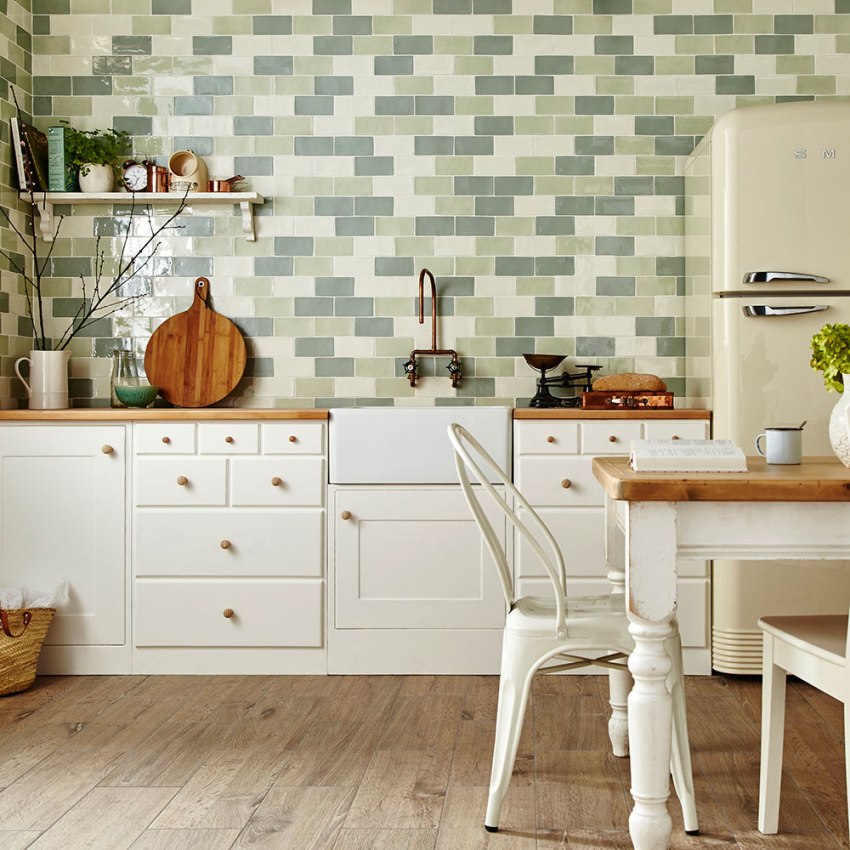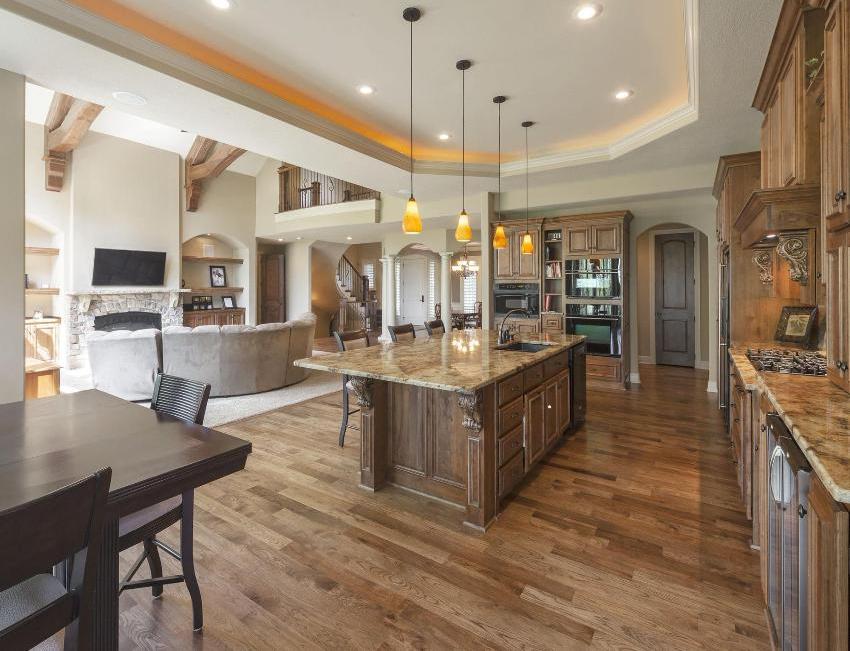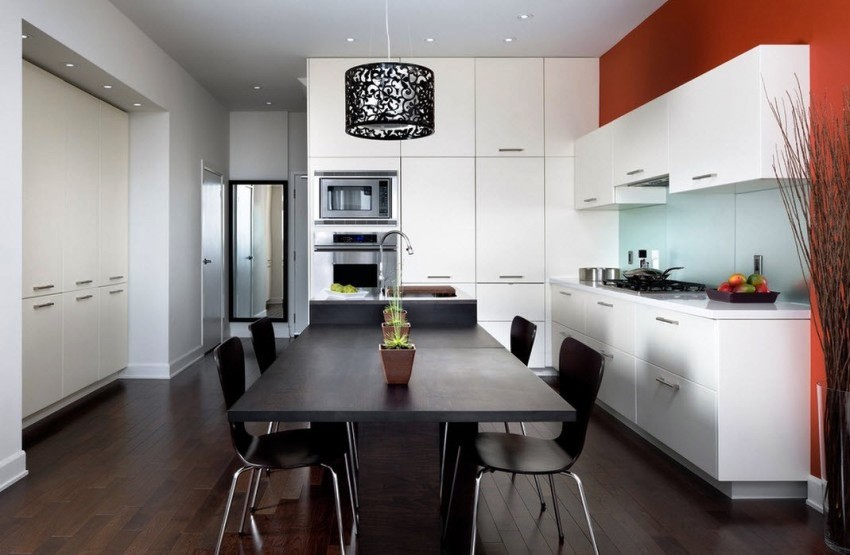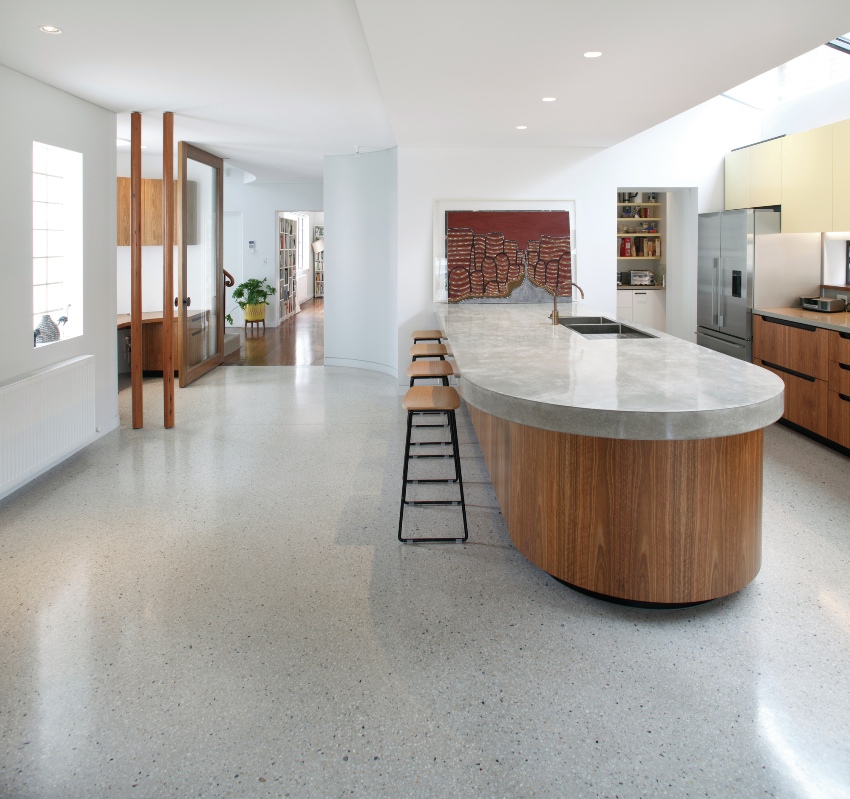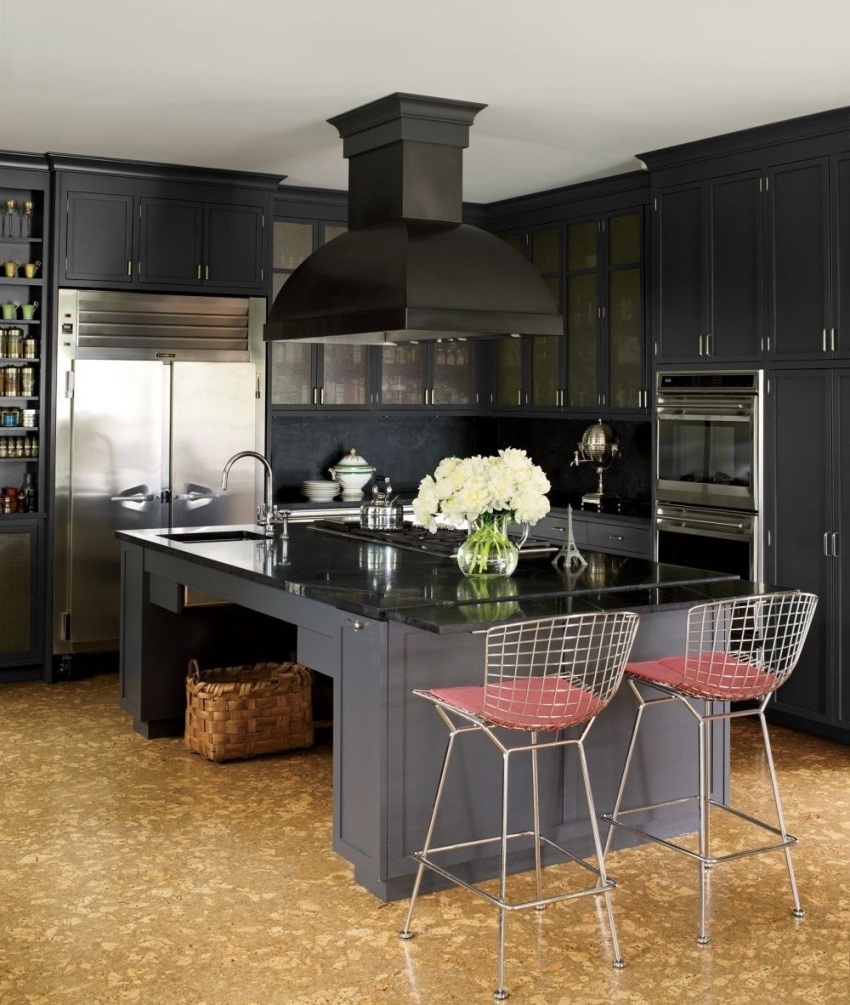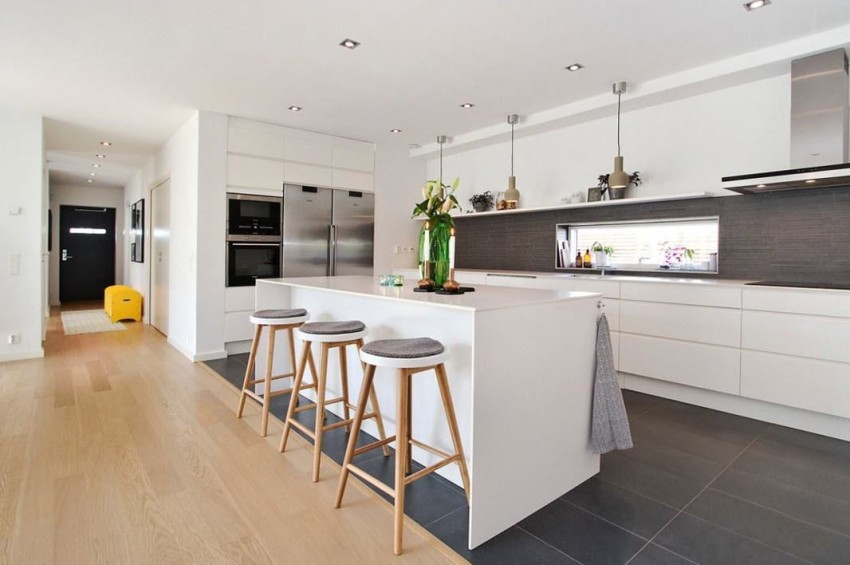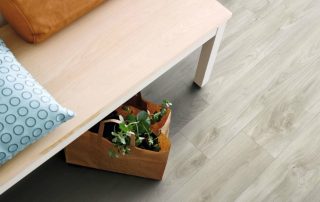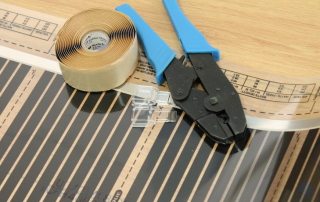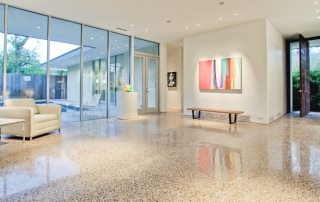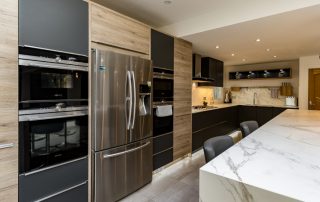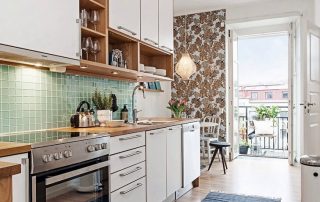The kitchen is a special room with a specific microclimate. The floor covering should not only fit harmoniously into the chosen interior, but also be comfortable, durable, reliable and durable. Which material should be installed on kitchen floors, which is better: practical tiles or high-quality laminate, traditional or liquid linoleum, or natural cork? This article will help you to consider this issue in detail.

When choosing a floor covering for the kitchen, it is important to give preference not so much to beauty as to practicality and durability.
Content [Hide]
- 1 What kind of floor to make in the kitchen: coating requirements
- 2 Which flooring is best for the kitchen: an overview of the varieties
- 3 Features of ceramic floor tiles for the kitchen
- 3.1 Advantages and disadvantages of ceramic tiles
- 3.2 What tiles in the kitchen to put on the floor: product specifications
- 3.3 Which tile is best for the kitchen on the floor: varieties of ceramics
- 3.4 Other popular ceramic tile options
- 3.5 Using porcelain stoneware flooring in the kitchen
- 3.6 PVC tiles on the kitchen floor: a budget option for a stylish coating
- 3.7 How to Tile the Floor in the Kitchen: Technician Review
- 4 Kitchen floors, which is better: linoleum or other material
- 5 Which laminate is better for the kitchen: selection rules
- 6 What is better linoleum or laminate flooring for the kitchen
- 7 Self-leveling floor in the kitchen: features of a modern coating
- 8 Cork flooring in the kitchen
- 9 Combining kitchen flooring
What floor to make in the kitchen: coverage requirements
When deciding which floor is best for the kitchen, one should first of all take into account the peculiarities of the room's microclimate. This space is characterized by high humidity, temperature fluctuations, a significant amount of grease and soot, so the floor must be made of a material that tolerates all these negative influences well.
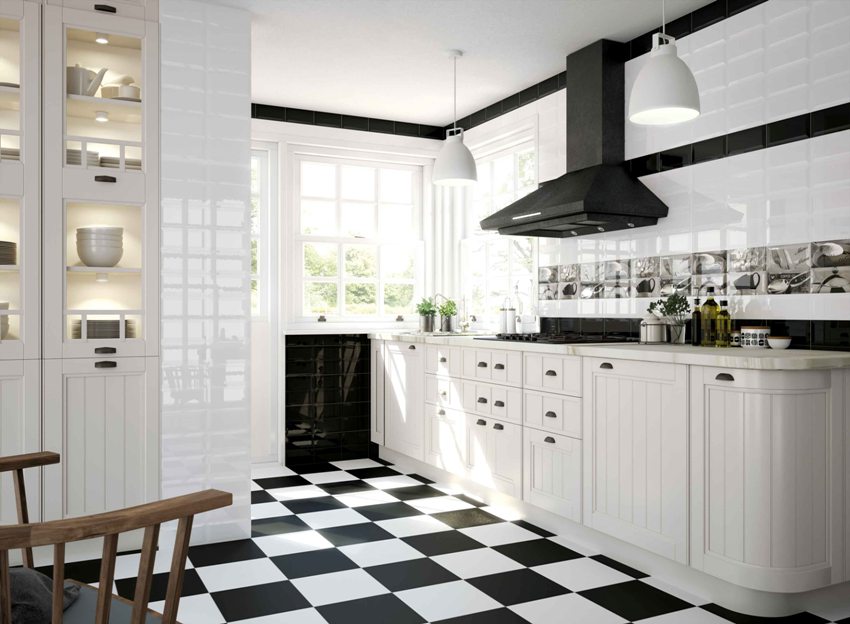
Ideal kitchen floors should be moisture resistant, easy to clean, have a solid surface and fit into the overall design
Based on the purpose of the room, the kitchen is characterized by the presence of all sorts of contaminants associated with the cooking process, therefore, it is necessary that the floor is quickly and easily washed, and this should not negatively affect its appearance. It is required that the material does not absorb moisture and grease. The surface must withstand frequent exposure to cleaning agents and brushes.
It is recommended that the floor covering be resistant to mechanical stress, not afraid of scratches and other minor damages that may arise as a result of frequent crowding in the room, movement of furniture elements, dishes and cutlery falling on the floor. The material must be wear-resistant, strong, resistant to aggressive influences and durable.
In addition to the required performance characteristics, it is necessary that the flooring blends harmoniously with the chosen interior of the room. Its design can be laconic, which will become the background basis for the rest of the interior elements, or bright, which will recreate the accent in the room.

The floor in the kitchen does not only depend on the style of the interior, it is very important to make sure that there is a suitable base for the chosen flooring
The color scheme of the floor covering must be selected not only taking into account the stylistic direction in which the room is designed, but also based on its dimensions. For small kitchens, preference should be given to monochromatic, homogeneous and light materials that will not unnecessarily overload the space. Also, it is not recommended to use a combined coating that visually reduces the area of the room. In a large 3x3 kitchen, the floor must be laid taking into account the zoning of the space, therefore, it is necessary to use different materials that are harmoniously combined with each other in texture and color.
Which flooring is best for the kitchen: overview of varieties
When choosing a floor covering for the kitchen, which today is presented in a wide range, it is recommended to first study the features of each material and the appropriateness of its use in this room.
Based on numerous reviews, kitchen floor tiles take a leading position among other coatings. Today in the construction market, it is presented in three types, where products differ in the composition of the material and the method of manufacture. Manufacturers produce ceramic, polyvinylchloride and porcelain stoneware tiles.
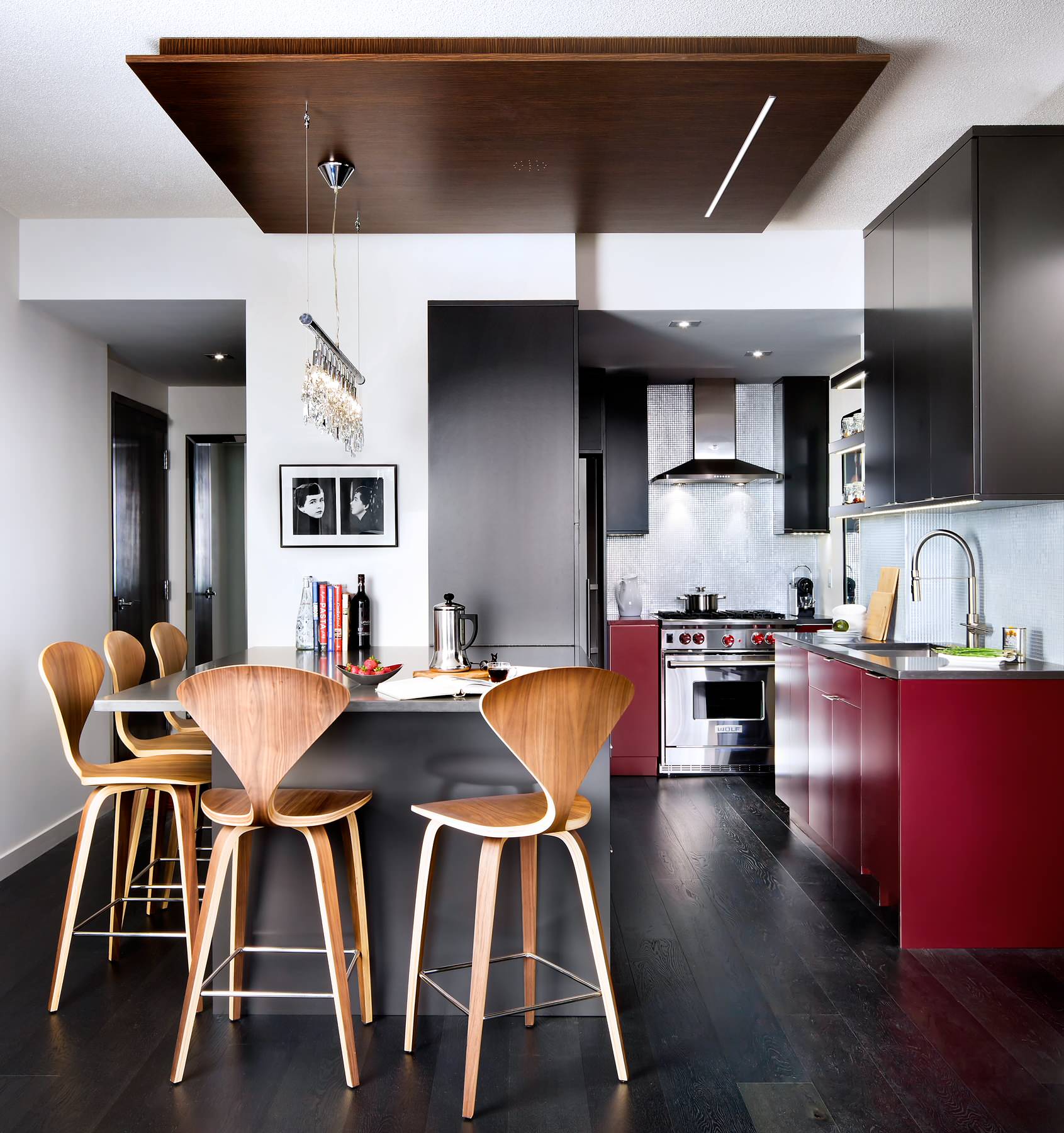
For a small kitchen, you should choose a homogeneous and monochromatic floor covering, such a floor will help to visually enlarge a small space
In second place in the ranking of kitchen flooring is linoleum, which is characterized by practicality, durability and wear resistance. The product is made from natural or synthetic components.
As a floor finish in the kitchen, you can use a laminate that combines durability and environmental safety. The product is presented in the form of a fiberboard or MDF board, on which a decorative film with imitation of valuable wood is glued. Further, the surface is covered with a protective layer that ensures the wear resistance of the material.
Self-leveling floors are a new-fashioned modern coating, thanks to which you can create an extraordinary and unique floor surface in the kitchen, which will become the highlight of the room. The most environmentally friendly is the cork floor, which is characterized by good technical and operational properties. Such material can be safely used for the kitchen.
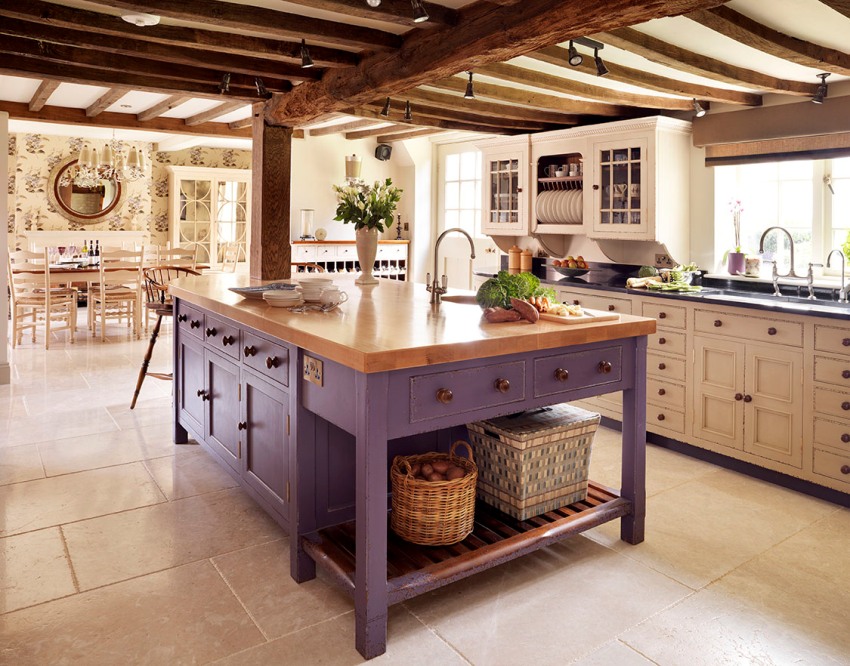
Choosing a floor covering for the kitchen, you need to take into account a lot of nuances - ease of cleaning, resistance to abrasion and moisture, and much more.
Features of ceramic floor tiles for the kitchen
Answering the question, which floor is better for the kitchen, we come to the conclusion that ceramic tiles take the leading position. It is a practical, durable, environmentally friendly, durable and inexpensive material that comes in a wide variety of designs and colors. Today you can pick up products that imitate all existing materials.
Clay and finely dispersed quartz sand are used as raw materials, due to which the percentage of shrinkage of slags, nepheline and feldspars is reduced, which subsequently has a positive effect on the structure of the products. In the manufacturing process, the material undergoes a pressing and firing procedure under certain conditions.
Ceramic tiles for kitchen flooring are available glazed and unglazed, with a smooth or ribbed surface. The product can be square or rectangular. The tiles are produced in different sizes and in a wide range of colors. The most popular dimensions are 30x30 and 50x50 cm. The back wall can be rough or glass. For rooms with high humidity, it is recommended to choose the first version of the products, since after laying the material, due to high adhesion, the probability of moisture penetration under the tiles is excluded. The price of tiles for the kitchen on the floor is in the range of 300-1200 rubles.
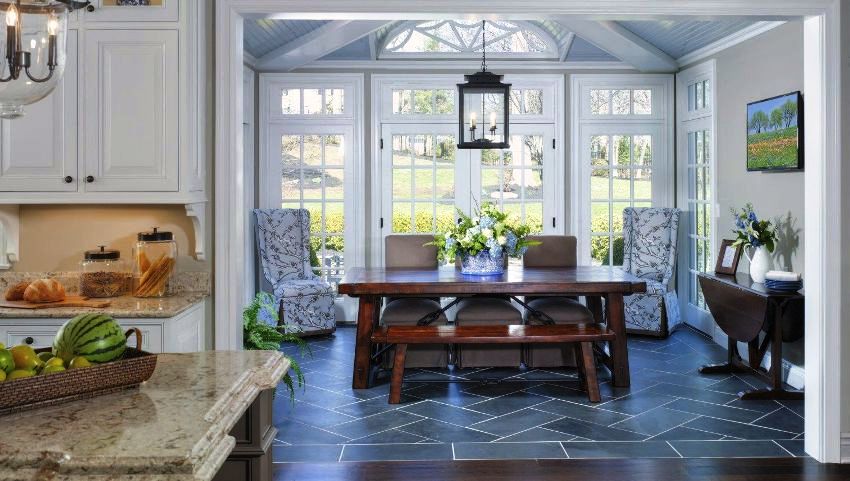
Ceramic tiles have a durable surface that is color-stable, abrasion-resistant and does not interact with household chemicals
Advantages and disadvantages of ceramic tiles
The tile is characterized by increased moisture resistance, resistance to aggressive detergents and cleaning agents, abrasion resistance, so when cleaning you should not fear for the aesthetic integrity of the coating.
The material is heat resistant, resistant to temperature extremes and solar radiation. The use of quality material, along with professional tiling on the kitchen floor, will provide a solid and reliable surface that can withstand significant loads and withstand mechanical stress. The tiles on the kitchen floor do not attract dust, which allows the surface to remain clean for a long time.
Along with the many advantages, ceramic tiles have their disadvantages. The material is characterized by a cold surface, which creates discomfort in further operation, however, in hot weather, this feature can be regarded as an advantage. Therefore, it is recommended to install a warm floor in the kitchen with ceramic tiles, so that the atmosphere in the room will become more comfortable in the cold season. A good practical and aesthetic solution is to combine tiles and laminate in the kitchen, which is clearly shown in the photo of the premises.
In order for the flooring to be durable, you should correctly and efficiently lay tiles on the floor in the kitchen. If there are air gaps between the product and the base, it will cause the material to peel off and further crack. It will be extremely problematic to pick up and replace damaged fragments, since the tiles are of the same type, but from different batches may externally differ significantly.
What tiles in the kitchen to put on the floor: product specifications
When choosing tiles for the kitchen floor, one should take into account the technical parameters of the product, such as the wear resistance class, the degree of hardness, the coefficient of friction and the chemical resistance class.
Important! Wall tiles must not be placed on the floor, as this product is characterized by lower strength and increased abrasion.
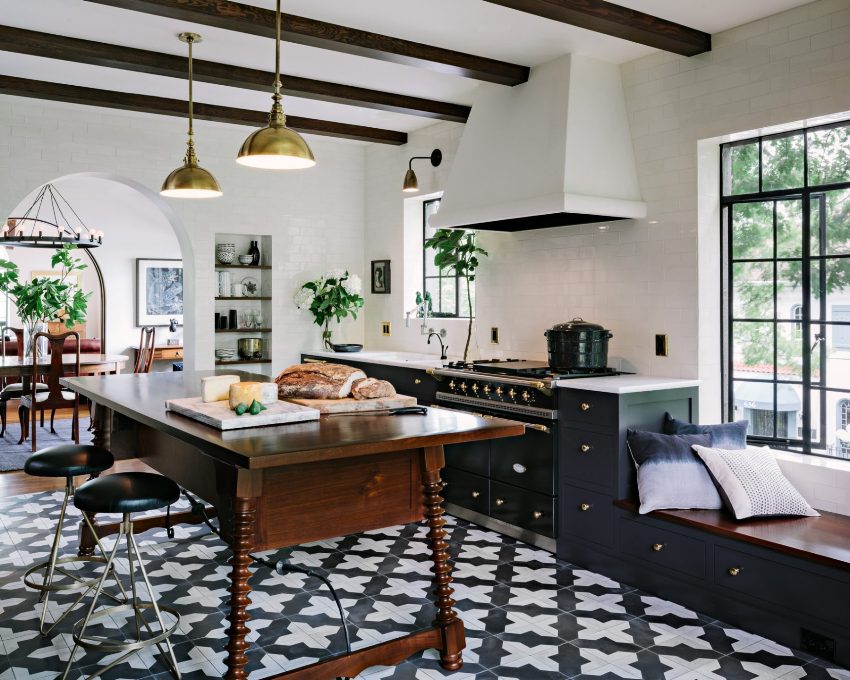
When choosing floor ceramic tiles, first of all, it is necessary to pay attention to their porosity.
A tile can belong to one of five classes of wear resistance, which is assigned to the product after determining the number of revolutions of the abrasive wheel over the surface of the element until signs of abrasion appear on the material. The higher the PEI, the stronger the product. For the kitchen, choose the PEI III, PEI IV models. The strongest are PEI class V products, however, they are intended for public crowded places.Buying such a tile for the kitchen is economically impractical.
The value of the degree of hardness of the product indicates the level of resistance of the material to shocks, scratches and other mechanical damage. This indicator is determined by the Mohs scale. For use in the kitchen, it is necessary to give preference to models with a degree of hardness of at least seven.
The coefficient of friction indicates the possibility of using the material for a particular room, so as not to cause traumatic situations. For the kitchen, it is recommended to choose tiles with a friction coefficient of at least 0.75% and marked at least R10. Such material can be used in rooms with high humidity.
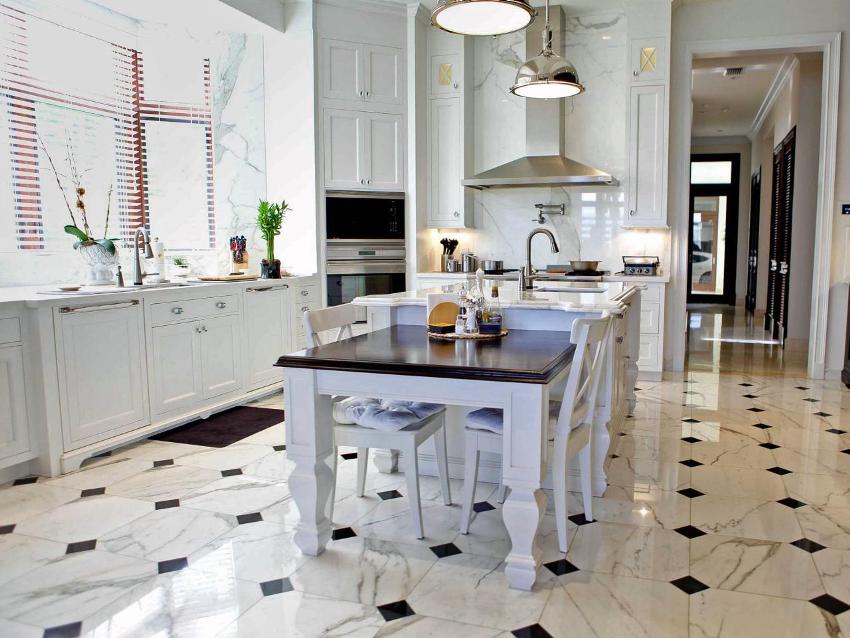
Durability is one of the main characteristics of floor tiles, which determines how long it will retain its appearance without changes.
It is imperative to take into account the ability of the material to resist aggressive chemicals, which determines the chemical resistance class of the tile. For the kitchen, it is necessary to choose products of class AA, which indicates the absolute resistance of the material to chemical attack and excludes the appearance of visible damage on its surface.
Useful advice! To significantly save money, you can use tiles with chemical resistance class A and B.
Which tile is best for the kitchen on the floor: varieties of ceramics
Manufacturers produce several types of ceramic tiles for the kitchen floor, the photos of the interior design clearly reflect this. Monocotture is represented by enamelled items. Due to the fact that a single firing of raw materials is used in the production of tiles, the coating is firmly connected to the bearing surface of the tile. This contributes to the creation of a material that is resistant to mechanical and chemical negative influences.
Bicottura is made as a result of double firing of the material, which is why the product is fragile. Next, an enamel coating is applied to the tiles, which is characterized by instability to abrasion. Despite the low cost of the material, it is not recommended to use it as a kitchen floor covering.
Related article:
Floor tiles for the kitchen: photos and prices of popular types
Ceramic, porcelain stoneware and quartz vinyl flooring. Review of tile manufacturers.
The kitchen floor made of monoporose tiles will look unusual and original. These are large squares, stylized as marble or granite. When laying the material, it is necessary to use an exclusively white grout. Despite the fact that the tile has an aesthetic appearance, it does not differ in increased strength, therefore, it is recommended to lay the products around the perimeter of the room, where there is less load on the tiles.
Other popular ceramic tile options
Cotto tiles are made of red clay by the extrusion method. The result is a matte product with an imitation of natural clay. To give the surface durability, the tiles should be treated with a protective wax waterproof layer at least once every two years.
Cottoforte is produced according to the principle of the previous version, but the product is covered with glaze, which makes the material waterproof, so that it does not need additional wax impregnation.
Majolica is made by double firing. The first stage is carried out at low temperatures, followed by drawing and glazing, after which the product is fired at a higher temperature. Such a tile with an elegant, uncluttered ornament will look stylish in kitchens decorated in Provence and country style.
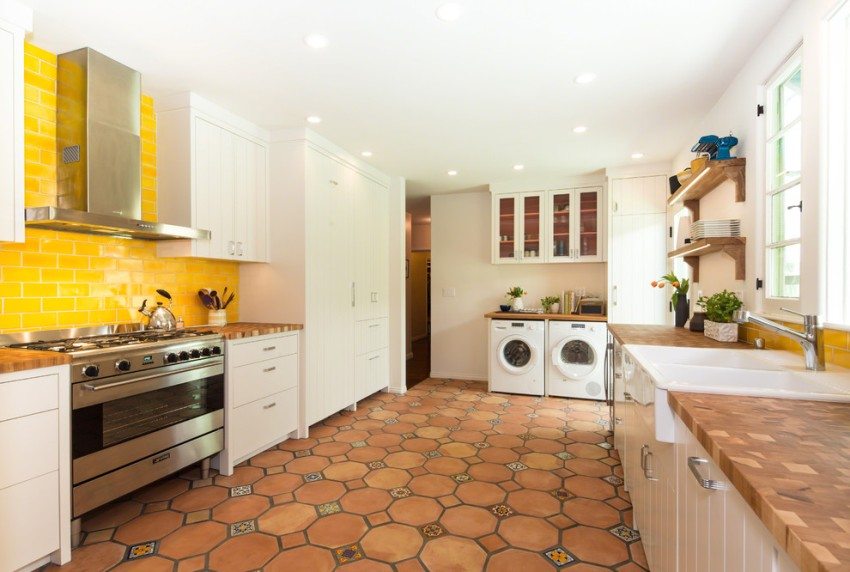
The glaze on the cottoforte tiles is applied opaque, and therefore it looks amazing on the kitchen floor
Unglazed tiles are characterized by high strength and moisture-resistant characteristics, which is ideal for covering floors in rooms with high humidity. In addition, the products are of low cost. However, these tiles have a limited range of colors. Popular gray tiles on the floor in the kitchen.
Useful advice! Unglazed tiles can be used as a discreet background to create an original pattern with other product options.
Glazed tiles are presented in a wider assortment due to the fact that a layer of glass glaze with a decorative pattern is applied to the ceramics. It can also be used as a floor covering, but the products are slippery and not durable.
Using porcelain stoneware flooring in the kitchen
When deciding which tile to choose for the kitchen on the floor, many prefer porcelain stoneware, which is superior to ceramics in terms of its technical and operational characteristics. For the manufacture of the material, a mixture of clays, quartz sand of the smallest fraction, as well as mineral pigments and metal oxide, which are used to paint the product, are taken.
Porcelain stoneware tiles for kitchens are distinguished by high strength, moisture resistance and resistance to chemically aggressive substances, impacts, mechanical stress, which is achieved due to the absence of pores and voids in the structure of the material. This is a consequence of the pressing step of the tile during the firing process. Porcelain stoneware is a wear-resistant and durable material.
The disadvantage of the product is the surface is too cold, which requires the creation of a warm floor in the kitchen under the tiles, this is especially important in a private house. Porcelain stoneware can be combined with ceramic tiles that are warmer. It can be used to fill the central part of the room, and to trim the perimeter with porcelain stoneware, as the photos of the tiles on the kitchen floor clearly display.
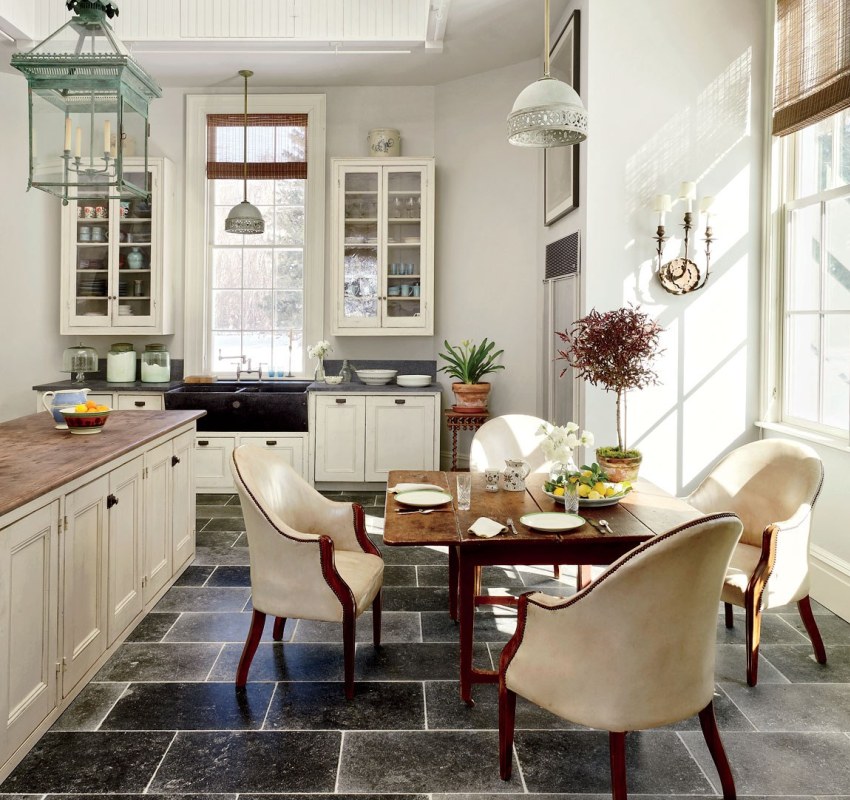
Cramogranite is resistant to moisture absorption, to aggressive environmental influences, and also prevents the appearance of stains on the surface of the material
Another disadvantage of the product is the limited color range of tiles. Mainly imitations of quartz, granite and marble are presented here. You can buy a product from 500 rubles. for a unit.
PVC tiles on the kitchen floor: a budget option for a stylish coating
PVC product is the warmest tile on the kitchen floor. The material consists of several layers: a protective moisture-repellent upper, polyurethane, decorative, vinyl base and an adhesive bottom with a protective film, which is removed during installation. The product is made in the form of a square or rectangular panel with imitation of parquet. During installation, the material looks like a seamless coating, which is clearly displayed by the photo of the tile in the kitchen on the floor under laminate or parquet.
Such tiles are characterized by moisture resistance, wear resistance, non-slip surface, good sound insulation properties, and immunity to chemically active components, which makes them ideal for use on the kitchen floor. For this purpose, it is recommended to choose products with a thickness of 2.5-3.5 mm.

PVC floor tiles - a versatile coating, first of all, attracting buyers with the resistance of the material
Installation of tiles is carried out as quickly and easily as possible due to the presence of a self-adhesive surface. However, this installation requires an even base, it is necessary that the floor surface does not contain dents or bulges. Depending on the tile options, PVC products have the lowest cost, which starts at 200 rubles.Also, the material is presented in a wide range of colors and a variety of patterns.
How to tile the floor in the kitchen: overview of techniques
The tiles are available in a wide variety of sizes, textures and shades. Using one of the techniques below, you can create a unique and original kitchen floor design from tiles.
The traditional way of laying this material is the parallel arrangement of products relative to the walls of the room. Two options are possible here: the elements of each subsequent row are placed one under the other, forming seams in the form of horizontal lines, or stacked with an offset of half the length of the tile, which resembles brickwork.
Tiles on the floor - photos of the kitchen show various options - can be positioned diagonally, which contributes to the visual expansion of the room. This is a more difficult and time consuming method of installation, which requires a lot of material. The tiles are carefully sized. Deviations in this case are unacceptable. The seams in the form of parallel lines should be at an angle of 45 degrees relative to the walls of the room.
When using tiles of contrasting shades, they are laid in a checkerboard pattern, which undoubtedly gives the room brightness and dynamism. Items can be arranged in the traditional way and diagonally.
Useful advice! For a spacious room, it is inappropriate to use large tiles. Small products or mosaics will look advantageous here.
You can get the original look of the flooring using the modular installation technique. Tiles of at least three standard sizes are used here. Identical segments alternate monotonically with each other, as a result, the surface looks nontrivial and rather unusual. It is important to choose products of the same texture, from the same collection, the length of which should be equal to each other.
Useful advice! For modular masonry, it is recommended to purchase products marked on the packaging "modulare".
The surface where the products are laid with the herringbone technology will look original. For this method, you can use tiles in the kitchen on the floor under the laminate. To organize a more effective appearance, you should use a contrasting grout for the joints.
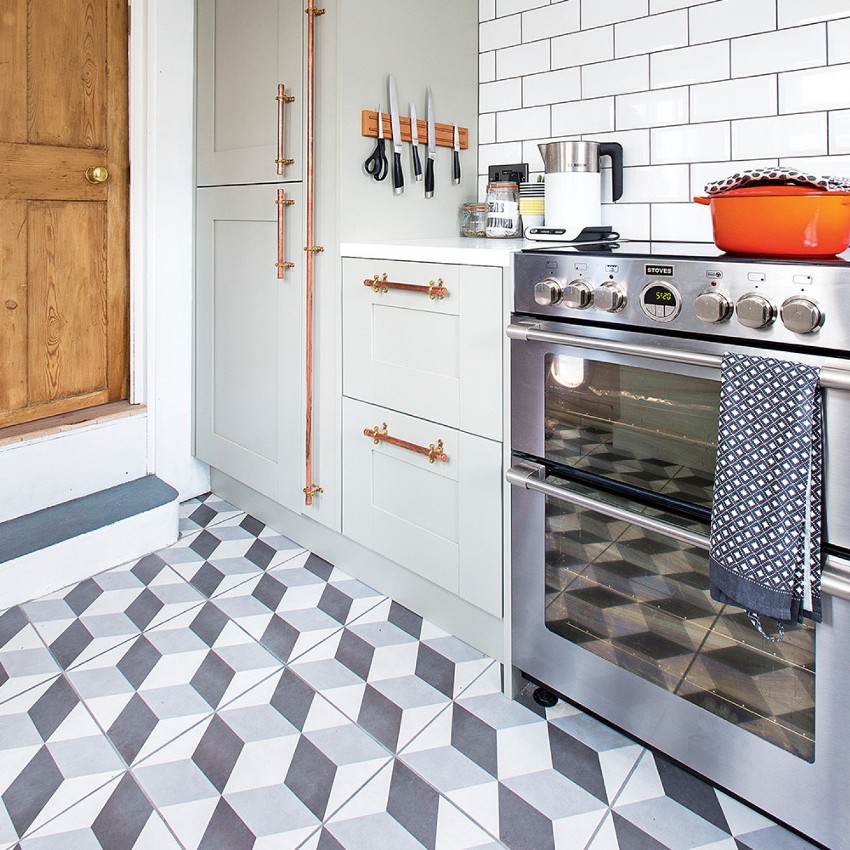
The process of laying ceramic tiles on the floor in the traditional way may well be carried out independently.
If wood-like tiles are used on the kitchen floor, you can use a variant of a regular braid, which will allow you to recreate an imitation of wood veneer weaves on the surface.
Kitchen floors, which is better: linoleum or other material
Linoleum is a convenient and practical floor covering for the kitchen that fits best in this particular room. The material has many distinctive advantages. A high-quality, expensive coating is distinguished by its strength, resistance to mechanical damage, wear resistance, durability, moisture, heat and noise insulation properties. The material does not need special care. Linoleum it fits quickly and easily, which does not require professional skills. This should be considered when choosing tiles or linoleum for the kitchen.
Important! To make the flooring look aesthetically pleasing, the base should be leveled for laying linoleum.
Natural or artificial materials can be used as raw materials for the manufacture of linoleum. In the first case, pine resin, jute fabric, limestone powder, linseed oil, wood or cork flour, and natural dyes are used.The second option is represented by products made of one- or two-layer PVC, which is based on fabric or non-woven heat-insulating material.
Natural products are characterized by environmental friendliness, bactericidal properties, durability (15-20 years), resistance to combustion, abrasion and moisture. The coating does not fade in the sun, does not fade after exposure to chemical detergents, which allows the product to retain its original color and texture for a long time. Linoleum is presented in a wide range of colors.
The disadvantages of natural products include high cost and fragility, which contributes to the cracking of the canvas when bending.
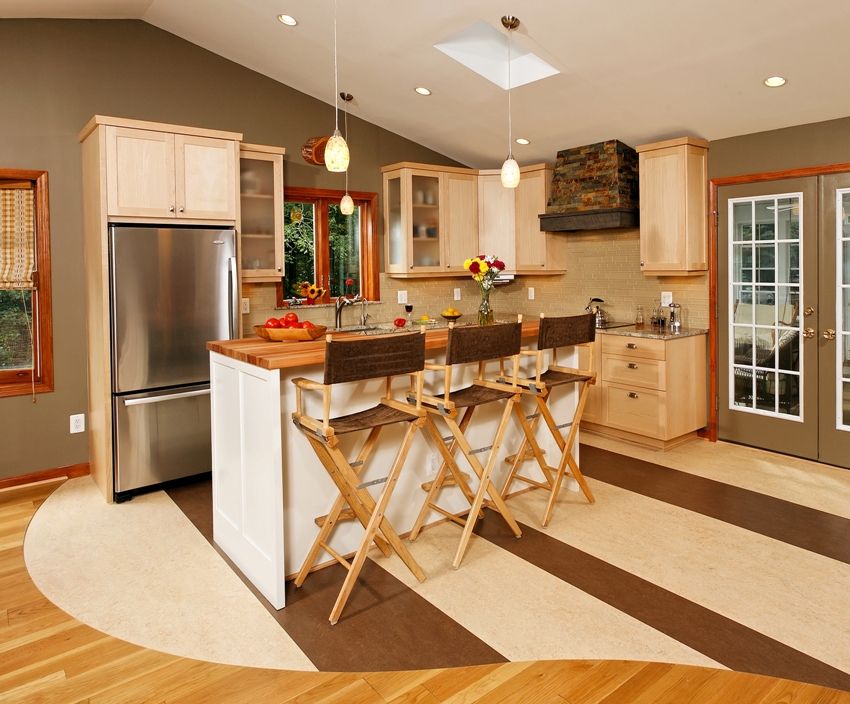
Linoleum is resistant to abrasion, is not afraid of moisture and hot steam, and is also easy to clean, which is very important for the kitchen
Among the advantages of PVC linoleum are the following: low thermal conductivity, environmental friendliness, current non-conduction, resistance to decay, sufficient elasticity, affordable cost and a wide palette of patterns, designs and colors. Products with imitation of wood and natural stone are very popular. Among the assortment presented, a worthy place belongs to linoleum for tiles, the photos clearly display different material options.
The disadvantages of the product include sensitivity to high and low temperatures, poor resistance to fats, alkaline and chemical solutions, and fragility (5-10 years).
For a room of any size, you can choose the appropriate dimensions of the material, so that it can be laid with a solid sheet. This will eliminate the formation of joints, which will positively affect the service life of the coating. The surface of the product is non-slip. There are options for which an anti-slip layer is additionally applied.
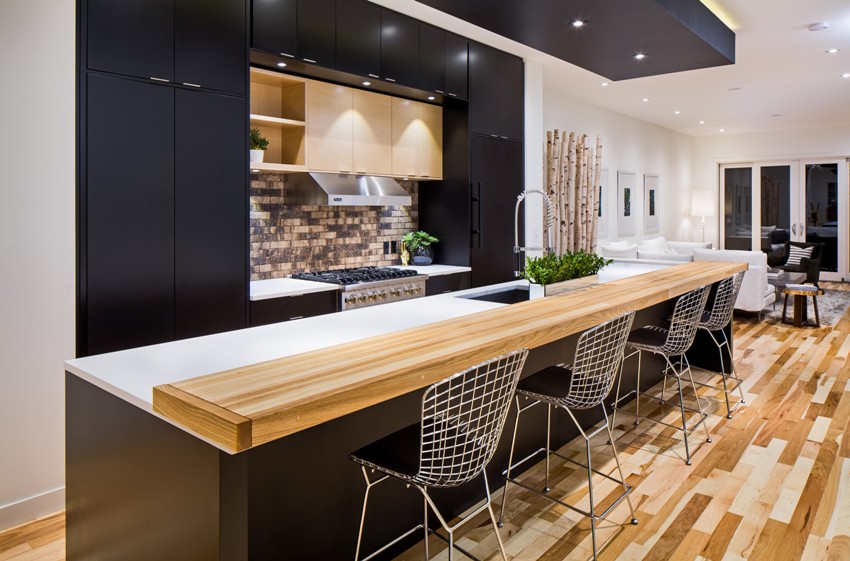
Linoleum is characterized by an inexpensive price, as well as a very simple installation method that you can master yourself
Important! When deciding what is better in the kitchen - linoleum or tiles, it should be borne in mind that the first option is a warmer and quieter coating.
Varieties of linoleum as a versatile flooring material
Linoleum can be one of three types: household, semi-commercial, and commercial. Each type is characterized by a class of wear resistance, which determines the appropriateness of using the material for certain premises.
Household linoleum is represented by foamed material covered with a protective layer with a decorative surface. The product is quite soft, due to which dents quickly form on the surface or traces of mechanical damage remain. The wear resistance class is 21-23, which indicates the possibility of using the material for residential premises with a small surface load. For the kitchen, this is not the best option.
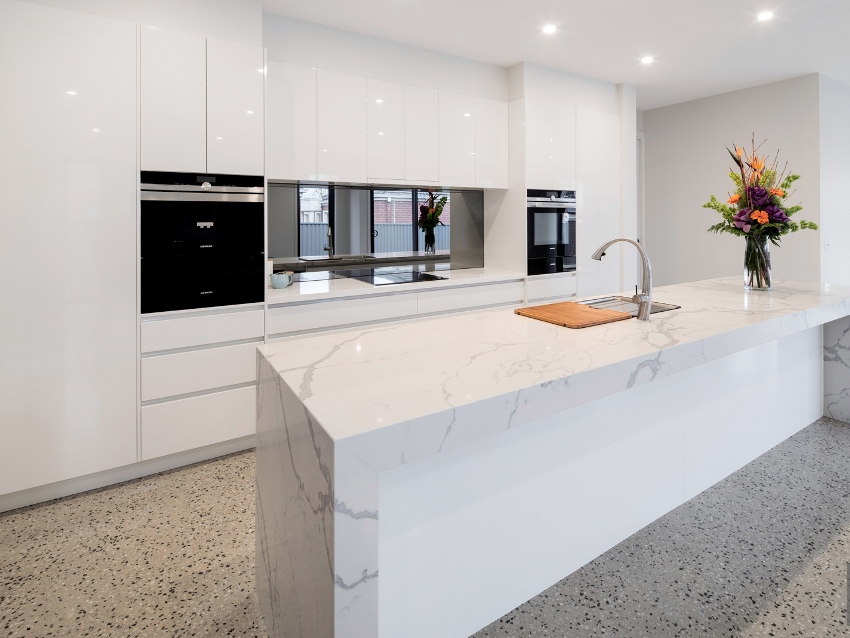
Semi-commercial linoleum will become ideal options for the kitchen, it has more significant characteristics than household
Semi-commercial linoleum is characterized by increased resistance to abrasion. This is the best option for the kitchen. The wear resistance class of linoleum is 31-34. The average cost of the product is 350 rubles / m². The commercial version is characterized by maximum density and durability. It is used for areas with increased surface stress, such as large shopping centers and industrial halls. The wear resistance class of products reaches 41-43. This option can also be used for kitchens, but it is economically impractical.
Manufacturers today produce improved types of linoleum, such as artoleums and marmoleums. These options are environmentally friendly and high cost. Each type of product can be with or without insulation, which affects the price of the product and its technical characteristics.
The choice of design and colors of linoleum for kitchen decoration
Today linoleum is presented in a wide range of colors and ornaments. Natural products are produced in a bright, rich color palette that does not fade in the sun. However, the decorative possibilities of PVC products are much wider. Here you can find imitations of wood, stone and ceramic tiles. The surface displays not only the look of oak, beech or cherry, but also exotic woods such as rosewood, bamboo and zebrano. Collections for parquet, mosaic and natural wood texture are very popular.
Linoleum looks spectacular under granite or marble. You can often find models on which aged natural materials are reproduced in the form of shabby stone or wood with traces of time.
Useful advice! Stone flooring should not be mixed with wooden furniture. This combination will look pretty wild.
Manufacturers offer linoleum with imitation of the marquetry technique, which is presented in the form of a mosaic of various types of veneer. Abstract designs or geometric motifs on the flooring look original, which can be used in minimalist and high-tech rooms. There are models in the form of solid rectangular strips of different widths. Using such a material, you can recreate parquet flooring end-to-end or in a herringbone on the floor. You can also use other masonry options to form unusual patterns.
A good solution is to use two different decors or options for contrasting shades, with which you can zone the room. This is clearly shown in the photo of the floor in the kitchen-living room.
Manufacturers also offer monochrome options with a variety of textures. For small rooms, you should choose light shades of the flooring. A kitchen with a dark floor will appear much smaller.
Which laminate for the kitchen is better: selection rules
When deciding which laminate to choose for the kitchen, you should pay attention to a number of technical indicators of the material. Depending on the level of wear resistance, the product is divided into classes, according to which the purpose of the material and its service life are determined.
The cheapest options, which are distinguished by low technical characteristics, correspond to wear resistance class 21. Products are afraid of moisture and mechanical stress. They are not recommended for kitchen floors. Laminate class 22-23 can be installed in this room, but its service life will not exceed five years. The most suitable option for the kitchen is a material of class 31-32, which has high moisture resistance and resistance to mechanical stress. The service life of the coating, if used correctly, is at least 12-15 years.
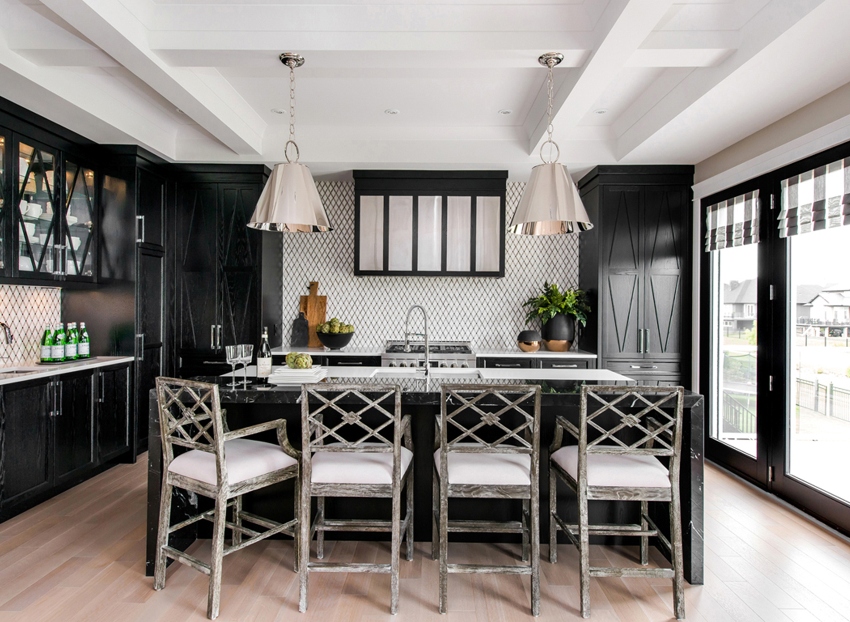
Laminate flooring can imitate all types of wood, including precious and exotic, so thanks to it you can make the interior of the kitchen unusual and original
When choosing a laminate, you should pay attention to the level of its moisture resistance, this should be reflected on the product packaging in the form of marking with a drop of water. An important criterion is the type of lock connection. For the kitchen, it is recommended to prefer glueless floor coverings with a collapsible system, which is a more reliable, durable option, easy to install.
Useful advice! For the kitchen, you should choose a material with a rough embossed coating to avoid traumatic situations.
The thickness of the product affects its service life without deformation and loss of the original appearance of the coating. For the kitchen, you need to give preference to a laminate not thinner than 9 mm. So that debris and moisture do not linger at the joints of the products, it is necessary to choose a material without chamfers.In residential premises, the laminate must be marked E0 or E1, which determines the safety of the material for human health.
Laminate can be waterproof and moisture resistant. These are different types of coverings that are made from different materials. Each of them behaves differently with water. The moisture-resistant laminate has a protective waterproof layer. Its locking joints are impregnated with a special wax-containing compound. However, if water gets into the seams between the items, they will swell and deform the floor. Waterproof laminate is made of plastic that is not afraid of contact with water. Unfortunately, the range of models for this material is very limited.
Laminate in the kitchen: pros and cons flooring
Can laminate flooring be used in the kitchen? The material is a good alternative to wood flooring. Despite the fact that the material is not too environmentally friendly, it has characteristic advantages:
- resistant to mechanical stress;
- wear-resistant;
- moisture resistant;
- pleasant to the touch warm surface;
- affordable price;
- presentable appearance that allows you to recreate the imitation of a parquet board;
- compatibility with the underfloor heating system.
When deciding on the choice: tile or laminate for the kitchen - one should take into account the disadvantages of the latter:
- a large number of butt joints that need to be processed with a sealant to reduce the likelihood of moisture or debris getting under the coating;
- does not withstand prolonged contact with water, which can lead to deformation of the product and will require replacement of the coating;
- the surface must remain dry in order to preserve the original appearance of the product for a longer time;
- instability of the surface to grease and aggressive cleaning agents that can ruin the appearance of the coating;
- low fire resistance;
- floors emit a characteristic ringing knock when a person walks on the floor.
Useful advice! For large families, it is not recommended to lay laminate flooring in the kitchen, which will last no more than five years.
Which laminate to choose for the kitchen: design options
Laminate is produced in the form of rectangular strips of different widths and lengths. The most popular format is a product with a length of 1200-1380 mm and a width of 190-200 mm. The material can be chamfered on two or four sides, or even around the entire perimeter. Laminate can be single-strip, where a pattern imitating wood is located across the entire width of the board, two-strip (the block is divided in half) or multi-strip. The different options are shown in the photo of the kitchen floor design.

The color, texture, "kind of wood" should be chosen based on personal preferences and focusing on the color of furniture and flooring in other rooms
Today you can buy laminate flooring for the kitchen, the price of which starts from 400 rubles. per sq. m, imitating a board or wood of different species: pine, walnut, ash, chestnut, oak, wenge and others. There are many variations in oak material: bleached, natural, aged, stained, tinted, under oil or varnish. Inexpensive products are produced with the same type of image on dies, and expensive coatings look more natural, since they have a clear pattern with transitions from light to dark, where the structure of the wood is clearly visible.
Among the options presented, a worthy place is occupied by a laminate for tiles. For the kitchen, this solution is suitable for those who prefer ceramics, but do not want to put up with its coldness. If the room is designed in a loft or high-tech style, you can choose a laminate for concrete.
What is better linoleum or laminate flooring for kitchen
Quality linoleum and laminate flooring are in the same price range.Therefore, the buyer often has a question, which is better - laminate or linoleum in the house? Both coatings are presented in a wide range of colors and decorative designs, they can imitate various coatings: wood, stone and tiles. Despite the listed positive properties, the appearance of linoleum is somewhat inferior to laminate. This is especially true for coatings with imitation parquet.
Each of the materials has sufficient moisture resistance, so it can be used in a room with a specific microclimate. However, if the laminate is poured with water, it will lose its original appearance and operational properties, after which it will be necessary to overhaul the floor in the kitchen.
Linoleum is represented by both synthetic and natural materials. Laminate is a completely man-made product. The service life, depending on the operating conditions, is practically the same for both materials. However, the laminate needs special care with the help of special detergents, thanks to which the original attractiveness of the surface can be preserved for a long time.
The structure of linoleum is much softer. Furniture dents remain on its surface. Contact with a hot object can ruin the appearance of the product. Such influences are not at all scary to the laminate. The thermal insulation properties of the laminate are higher than those of linoleum. For expensive options, this figure is higher than for budget laminate models. Linoleum laying is much faster and does not require special skills. Installing laminate flooring is more time consuming.

The difference between the cheapest representatives of linoleum and laminate will be a multiple of about two
Self-leveling floor in the kitchen: features of modern coating
The self-leveling floor is also called liquid linoleum, which is similar in appearance to it, and when it comes into contact resembles ceramic tiles. The main advantages of the material are high rates of mechanical resistance, strength, wear resistance, durability and ease of use. This is a non-toxic, fireproof floor finish.
When installing the self-leveling floor, seams and joints are not formed, which allows you to create a uniform smooth surface, which is characterized by increased resistance to moisture. Filling all cracks, voids and cracks, liquid linoleum forms an airtight coating, so the floors do not need to be waterproofed beforehand.
The material has good adhesion and adheres to any substrate, so it does not require preliminary dismantling of the old coating. In addition, self-leveling floors are a self-leveling mixture. The layer thickness is 1-7 mm, this value depends on the humidity and temperature in the room. For the kitchen, this value is 3-5 mm. However, one should take into account the fact that dismantling such a floor is a laborious and complex process.
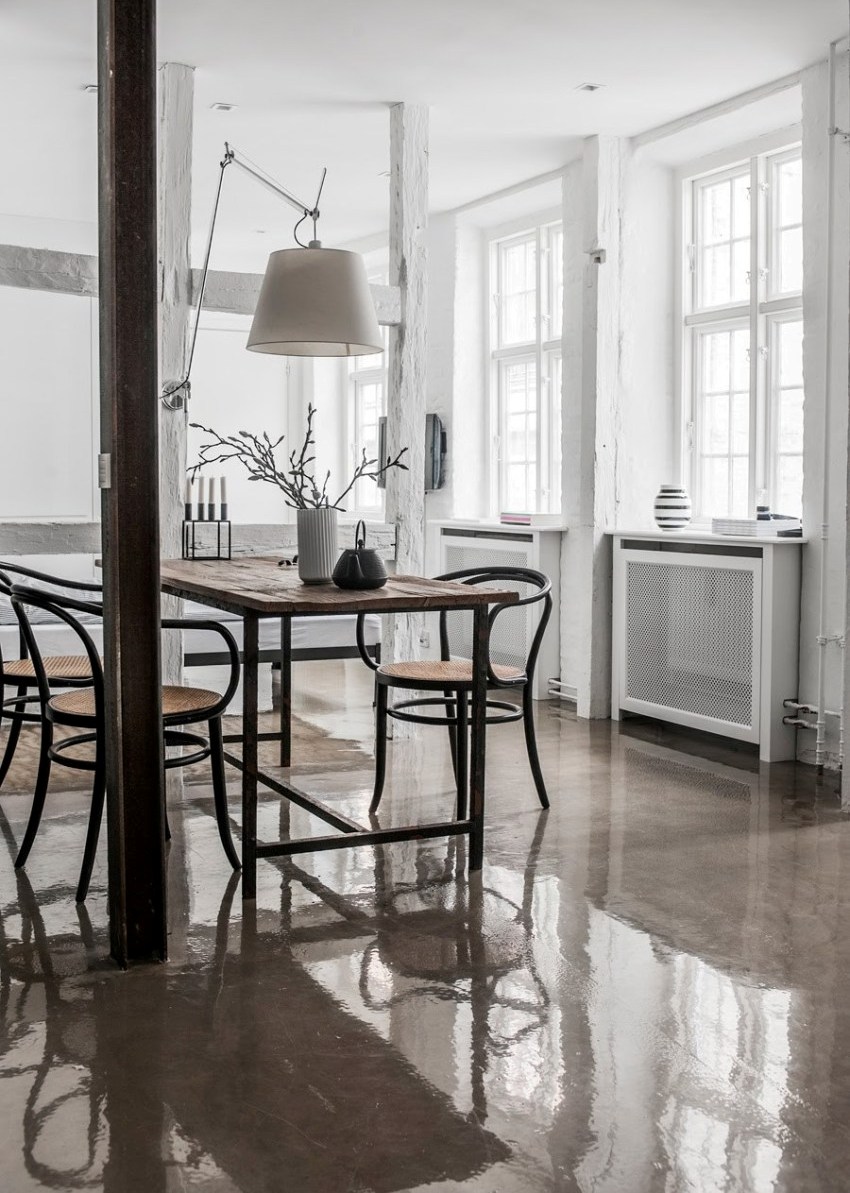
The surface of the self-leveling floor is resistant to increased moisture and easily withstands the load generated by furniture
There are several types of self-leveling floors that differ in composition, quality and reliability. A universal option is the methyl methacrylate type, which has increased strength, mechanical resistance and durability. It hardens quickly even at low temperatures.
The epoxy self-leveling floor is endowed with strength, resistance to impacts and aggressive chemicals, so it can be used in bathrooms, kitchens, swimming pools. Polyurethane material has increased strength and elasticity, resistance to any chemical and mechanical stress. The coating is able to withstand any loads, including point loads with low weight. This is a good option for the kitchen.The most budgetary option is a cement-acrylic floor with good technical and operational characteristics. You can buy material from 350 rubles. for 25 kg.
Varieties of self-leveling floor design
A wide range of colors and design options will allow you to create a beautiful and presentable floor covering that fits perfectly into any room interior.
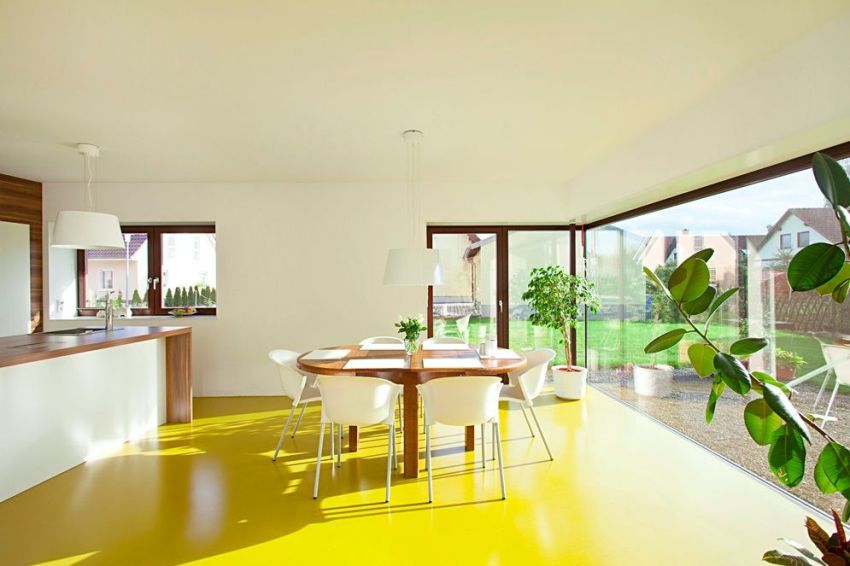
An important advantage of self-leveling floors is the variety; they can be easily used in both classic and modern designs.
Self-leveling 3D floors in the kitchen are very popular today, the photos clearly display interesting options. Various images and patterns are created on the surface thanks to the material. This design will make the room extraordinary and individual. The selected pattern is printed on banner fabric or on self-adhesive vinyl of the required size. It is laid on the base layer, after which the surface is filled with varnish. The image can be applied to the base layer using acrylic or polymer paints.
Useful advice! When creating a bulk 3D floor, you should use the services of specialists who will do the job efficiently and quickly.
Manufacturers offer options to recreate the texture of marble, granite, and other non-trivial surfaces. Special mixtures are very popular: acrylic chips, flocks and glitters. Flocks are monochromatic, two-colored, resembling straws, scales or bubbles.
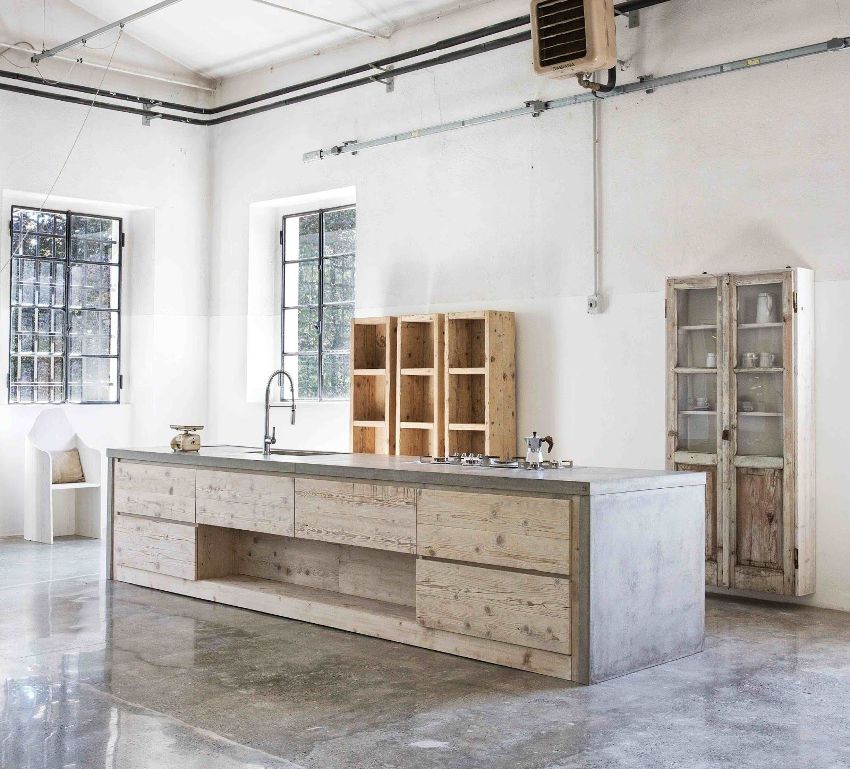
A significant advantage of self-leveling floors is resistance to ultraviolet light and aggressive components
The floor will look interesting and lively, containing splashes of glitter. Here you can use a flock mix of unobtrusive pastel shades, it will fit into the interior country style kitchens and provence.
Cork flooring in the kitchen
Lovers of natural finishes should pay special attention to cork, for the manufacture of which cork oak bark is used. Such a floor is pleasant and beneficial for a person's feet. It is an environmentally friendly and safe material ideal for flooring kitchens and other areas where people with allergies live. The material is fire resistant, characterized by good noise insulation. No mold or mildew forms on its surface. If, after mechanical action, a trace remains on the surface, due to the porous texture, the impact site will be invisible.
The cork surface is practical, does not attract dust and other debris, and is easy to maintain. However, it does not differ in increased moisture resistance. Therefore, for kitchens, the floor should be covered with a layer of protective varnish. The bark of cork oak can have different shades and structures, which makes it possible to choose the model most suitable for a particular room interior.
Cork floors are divided into types:
- adhesive tiles with and without a protective top layer;
- granules, rolls, plates, which are used as a sound and heat insulation base for flooring;
- cork parquet in the form of rectangular MDF panels, which are mounted by means of a lock connection.
The main disadvantage of the material is its high cost, which competes with parquet. Price for 1 sq. m. cork floor starts from 3000 rubles.
Combining kitchen flooring
There is no definite answer to the question of which floor is the best to do in the kitchen. Each of the proposed finishing materials has its own advantages and disadvantages. Therefore, very often when creating a floor covering, two or more materials are used at the same time, so that the common space can be zoned.
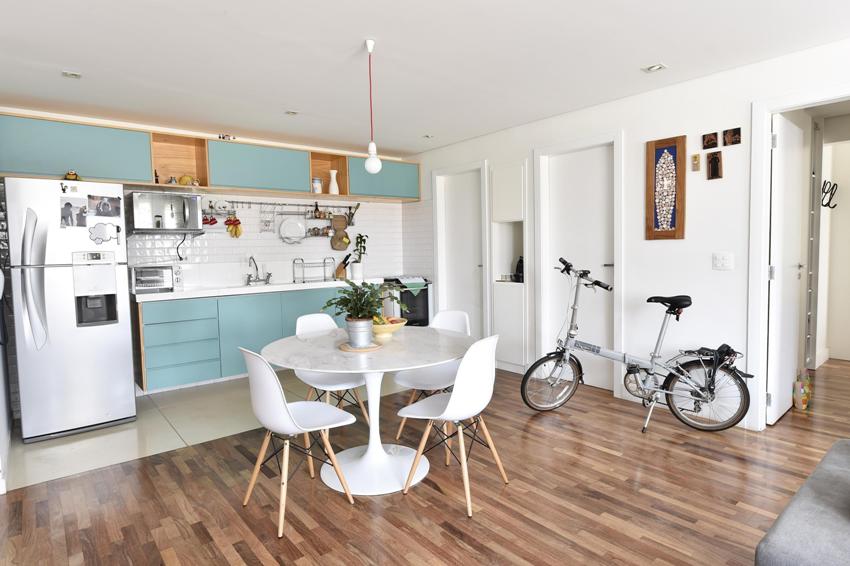
Often, designers offer to combine two floor coverings, depending on the functional area of the kitchen.
The most popular option is a combined laminate and tile kitchen floor. The first type of material can be laid in the dining area. The warm foot surface provides additional comfort. The second material covers the area covering the place under the sink, refrigerator, stove, protruding 1 m from the workplace. Photos of tiles and laminate on the kitchen floor clearly reflect the use of coatings in the interior.
Both materials must be of the same thickness. The main condition for such a combined floor in the kitchen: tiles and laminate must have shades that are harmonious in relation to each other. The shape of the joint can be straight or curved, depending on the design of the kitchen. The seams are camouflaged with flexible or rigid thresholds made of metal, plastic or cork.
A good symbiosis of convenience and practicality is the use of tiles and linoleum for the kitchen floor. The combination of materials is carried out according to the principle of the previous combination. But this is a budget option, since you can pick up a cheaper option. linoleum, the surface of which will imitate parquet or wooden floor in the kitchen.

The working area of the kitchen floor is tiled with practical ceramics, and the dining area is lined with laminate
A harmonious combination of laminate flooring and porcelain stoneware tiles for the kitchen floor will look stylish, expensive and presentable, which should be located at the entrance to the room and in a place where water and grease can get into. Here it is better to give preference to a matte surface that does not slip, washes well and does not rub off.
For those who cannot decide what is better in the kitchen - laminate or linoleum, you can safely combine both materials, placing the first in the dining area, and the second in the working area.
There is no definite answer which is better in the kitchen - laminate or tiles, self-leveling floor or linoleum... Each material is distinguished by its characteristic features, which should be guided first of all. Among a wide variety of color and design solutions, you can choose the right option that will match your personal preferences and pricing.
